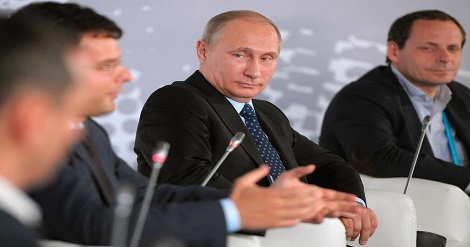Q & A with Gen. Robert P. Ashley, Jr., Trump’s Director of the Defense Intelligence Agency
 Lieutenant General Robert P. Ashley, Jr. became the 21st Director of the Defense Intelligence Agency (DIA) on October 3, 2017. He formerly served as the Army Deputy Chief of Staff, G-2, where he was the senior advisor to the Secretary of the Army and Army Chief of Staff for all aspects of intelligence, counterintelligence, and security.
Lieutenant General Robert P. Ashley, Jr. became the 21st Director of the Defense Intelligence Agency (DIA) on October 3, 2017. He formerly served as the Army Deputy Chief of Staff, G-2, where he was the senior advisor to the Secretary of the Army and Army Chief of Staff for all aspects of intelligence, counterintelligence, and security.
Since so much media attention is being paid to another former DIA director, Lt. Gen. Michael Flynn, U.S. Army-Ret., Conservative Base decided to run one of the Gen. Ashley’s recent presentations for intelligence and law enforcement agencies, as well as members of the news media, who sadly gave Ashley scant media coverage preferring the likes of John Brennan, ex-CIA chief, and James Clapper, ex-Director of National Intelligence (DNI).
Lieutenant General Ashley is a career army military intelligence officer with assignments in Fort Bragg, NC, Washington, DC, Fort Gordon, GA, MacDill Air Force Base, FL, Izmir, Turkey, and deployments to Operation JOINT FORGE, Sarajevo, Bosnia-Herzegovina, Operation IRAQI FREEDOM, Iraq, and Operation ENDURING FREEDOM, Afghanistan.
He has commanded at the company, battalion, squadron, and brigade levels with combat tours in Iraq and Afghanistan as a squadron, brigade commander, and J-2. His commands include the 206th Military Intelligence Battalion, Fort Gordon, GA, Intelligence Squadron, Office of Military Support, Washington, DC, and the 525th Battlefield Surveillance Brigade (Airborne), XVIII Airborne Corps.
Other key assignments include the Director of Intelligence, United States Army Joint Special Operations Command; the Director of Intelligence, United States Central Command; the Deputy Chief of Staff, Intelligence, International Security Assistance Force and Director of Intelligence, United States Forces, Afghanistan; and Commanding General, the United States Army Intelligence Center of Excellence and Fort Huachuca, AZ.
Lieutenant General Ashley has a Bachelor of Arts degree in Political Science from Appalachian State University, a master’s degree in Strategic Intelligence from the National Intelligence University (formerly known as the Defense Intelligence College) and a master’s degree in Strategic Studies from the United States Army War College. His awards and decorations include the Defense Superior Service Medal (2OLC), Legion of Merit (1OLC), and Bronze Star Medal (2OLC). Lieutenant General Ashley has also earned the Parachutist Badge, Army Aviation Crewmember Badge, Army Staff Identification Badge, and Australian Parachutist Badge.
Conservative Base: General Ashley, after the cold war was declared a victory for the Free World after more than four decades, Americans breathed a sigh of relief that leaders from the United States and the former Soviet Union were discussing a decrease in the number of nuclear weapons in each nation’s arsenal. However, now it seems that United States leaders — political and military — miscalculated the results of those talks and agreements. What happened?
 General Ashley: After working together for decades to achieve real nuclear reductions, Russia is [now] upgrading the capacity of its nuclear forces. We assess its overall nuclear stockpile is likely to grow significantly over the next decade. This assessed growth is primarily driven by a significant projected increase in the number of Russia’s non-strategic nuclear weapons. Russia is adding new military capabilities to its existing stockpile of nonstrategic nuclear weapons, including those employable by ships, aircraft, and ground forces. These nuclear warheads include theater- and tactical-range systems that Russia relies on to deter and defeat NATO or China in a conflict.
General Ashley: After working together for decades to achieve real nuclear reductions, Russia is [now] upgrading the capacity of its nuclear forces. We assess its overall nuclear stockpile is likely to grow significantly over the next decade. This assessed growth is primarily driven by a significant projected increase in the number of Russia’s non-strategic nuclear weapons. Russia is adding new military capabilities to its existing stockpile of nonstrategic nuclear weapons, including those employable by ships, aircraft, and ground forces. These nuclear warheads include theater- and tactical-range systems that Russia relies on to deter and defeat NATO or China in a conflict.
Russia’s stockpile of non-strategic nuclear weapons—already large and diverse and is being modernized with an eye towards greater accuracy, longer ranges, and lower yields to suit their potential warfighting role.
Conservative Base: Does the Pentagon know how many nuclear weapons systems are already deployed?
General Ashley: We assess Russia to have dozens of these systems already deployed or in development. They include, but are not limited to: short- and close-range ballistic missiles, ground-launched cruise missiles, including the 9M729 missile, which the U.S. Government determined violates the Intermediate-Range Nuclear Forces or INF Treaty, as well as antiship and antisubmarine missiles, torpedoes, and depth charges.
For comparison, the United States currently has a single non-strategic nuclear weapons system: The B-61 gravity bomb.
We assess Russia possesses up to 2,000 such non-strategic nuclear warheads not covered by the New Start Treaty and because of a lack of Russian transparency we have uncertainty in our understanding of the scope and disposition of their stockpile.
Accurately accounting for these non-strategic nuclear weapons delivery systems is not only complicated by a lack of transparency but their dual-capable nature. Most Russian systems lack externally distinguishing features that would allow observers to differentiate between conventional and nuclear variants.
Conservative Base: In one of your recent lectures, you mentioned the INF Treaty [ Intermediate-Range Nuclear Forces Treaty], and the 1992 Presidential Nuclear Initiatives. Are the Russians under President Vladimir Putin in compliance with those agreements?
 General Ashley: Where limits or reductions have existed, such as with the INF Treaty or the 1992 Presidential Nuclear Initiatives, the United States assesses that Russia has not fulfilled them. This is exemplified by the development of the 9M729 ground launched cruise missile.
General Ashley: Where limits or reductions have existed, such as with the INF Treaty or the 1992 Presidential Nuclear Initiatives, the United States assesses that Russia has not fulfilled them. This is exemplified by the development of the 9M729 ground launched cruise missile.
By 2015, Russia had completed a comprehensive flight test program consisting of multiple tests of the 9M729 missile from both fixed and mobile launchers that appeared to be purposefully designed to disguise the true nature of their testing activity, as well as the true capacity of the missile.
While compliance determinations such as the INF Treaty are ultimately made by the U.S. interagency policy community, I want to be clear about the role of the Intelligence Community. It is the job of the Intelligence Community (IC) to analyze those activities that have implications for a country’s international obligations. The IC does not use the word compliance but rather characterizes actions as “inconsistent” with the intent of such treaties and uses those assessments to help inform the interagency process.
From an interagency standpoint, the U.S. has determined Russia’s actions have strained other key pillars of arms control architecture, including the Chemical Weapons Convention, Open Skies Treaty, the Vienna Document, and the Treaty on Conventional Armed Forces in Europe.
Conservative Base: What about tactical (non-strategic nuclear weapons? Is there an increase in Russia’s stockpile?
General Ashley: [As far as growth] in non-strategic nuclear weapons, Russia claims to be developing new warhead designs for strategic systems, such as new high-yield and earth-penetrating warheads to attack hardened military targets like U.S., Allied, and Chinese command and control facilities.
Russia’s development of new warhead designs and overall stockpile management efforts have been enhanced by its approach to nuclear testing. The United States believes that Russia probably is not adhering to its nuclear testing moratorium in a manner consistent with the “zero-yield” standard.
Our understanding of nuclear weapon development leads us to believe Russia’s testing activities would help it to improve its nuclear weapons capabilities. The United States, by contrast, has forgone such benefits by upholding a “zero-yield” standard.
Conservative Base: Do you and the military have any other concerns regarding Russia’s nuclear weapons program?
General Ashley: An increase in its overall nuclear warhead stockpile is not the only source of concern stemming from Russia’s broad-based nuclear modernization program.
Within the confines of the New START Treaty, Russia claims its overhaul of its strategic rocket forces is roughly 70% complete. Every leg of Russia’s triad is being modernized and Russia is fielding new strategic systems, including road-mobile and silo-based intercontinental ballistic missiles (ICBMs), a submarine-launched ballistic missile, an upgraded strategic nuclear bomber, and a strategic air-launched cruise missile.

Many of these new systems have a greater warhead delivery capacity than the systems they are replacing. For example, Russia’s aging SS-25 road-mobile ICBM carries a single nuclear warhead, while its replacement—the SS-27—can carry multiple warheads, providing Russia significant capability to “upload” additional warheads onto its strategic delivery systems. The SS-18—Russia’s aging heavy ICBM—carries up to 10 nuclear warheads, while the Russian president claims the Sarmat—its replacement—will carry even more warheads or Russia’s new nuclear-armed “Avanguard” hypersonic glide vehicle.
While we assess Russia is currently adhering to the New START Treaty limits on deployed warheads, this upload capacity will give Russia the ability to increase the number of deployed warheads in a time of crisis. Russia is also pursuing novel nuclear delivery systems that create a strategic challenge for the U.S. and which are difficult to manage under current arms control agreements.
President Putin unveiled these systems, which include: an intercontinental-range, nuclear-powered and nuclear-armed underwater drone; a nuclear-powered, nuclear-armed intercontinental-range cruise missile; and an air-launched ballistic missile. Russia also continues to modernize its existing automated nuclear command and control launch system, known as “Perimeter.”
President Putin’s high-profile announcement makes clear that Russia is continuing to prioritize investment in its nuclear forces, even at a time of domestic budgetary constraints.
These new nuclear capabilities have come at the expense of other Russian defense priorities, such as the development of a new aircraft carrier, because Russia sees its nuclear weapons as the ultimate guarantor of the country’s survival, perceives a warfighting role for their use, and directs its scarce resources to its nuclear modernization effort.


